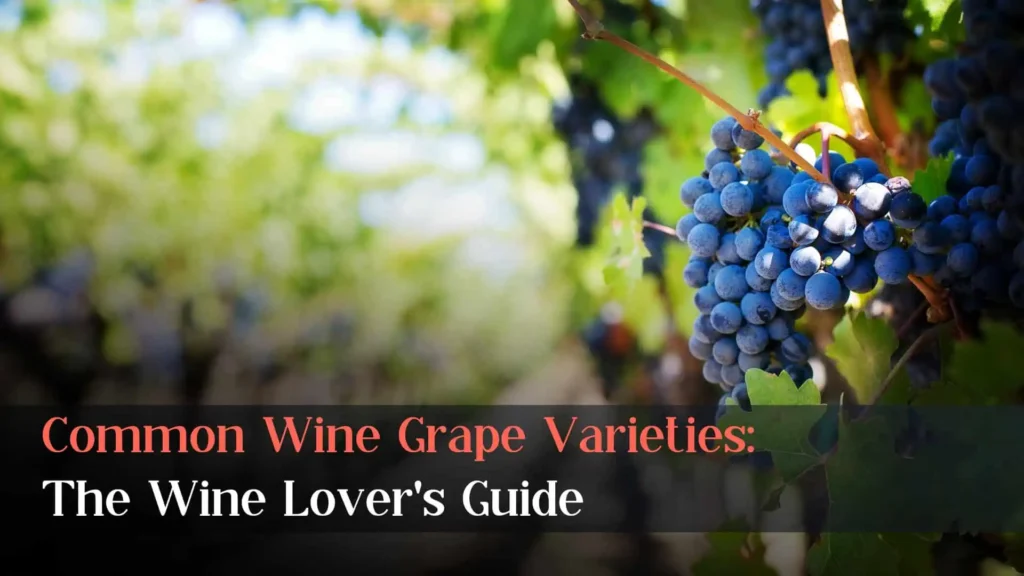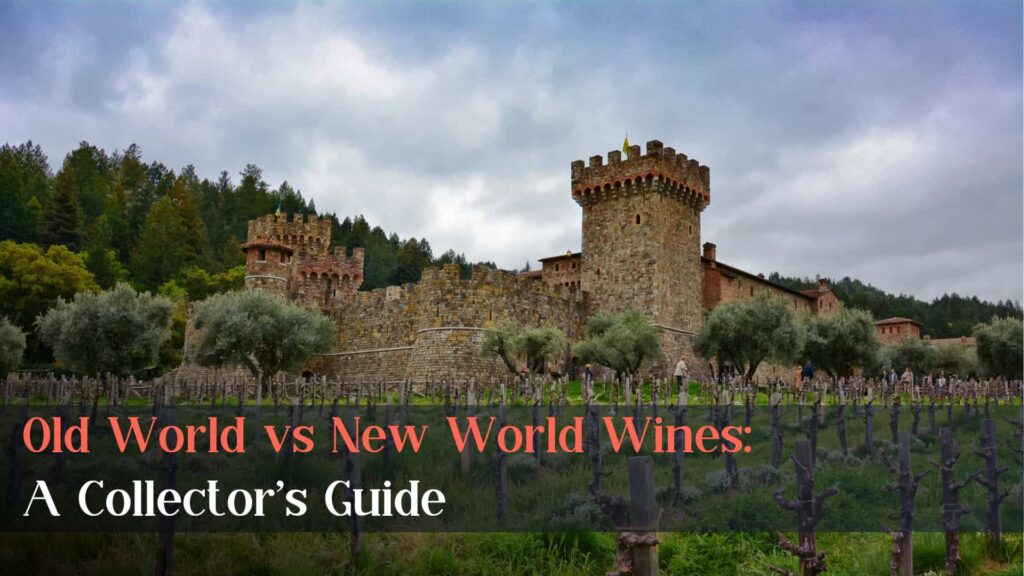Proper wine storage is a crucial aspect of wine enjoyment and collection, whether you are a seasoned collector, a savvy investor, or a business owner in the food and beverage industry. Wine is a delicate and complex beverage that requires specific conditions to maintain its quality, flavor, and value over time. Neglecting to store your wine correctly can lead to a range of issues, from altered taste profiles to spoilage, ultimately diminishing the enjoyment and potential of your collection.
At GrtWines, we understand the importance of proper wine storage and are committed to educating our clients and the wider wine community about best practices. We work directly with the negociants and suppliers of Bordeaux who provide state-of-the-art storage solutions to ensure your wines are stored in the best possible conditions. Through these relationships we’ve learned the ins and outs of wine storage, and want to share our knowledge and expertise. We hope this article can help provide some guidance and information to help wine collectors, investors, and businesses alike to protect their purchases and ensure that their wines remain in pristine condition until they are ready to be enjoyed.
Table of Contents
Toggle
The Key Elements of Proper Wine Storage
Wine Storage Temperature
Temperature is one of the most critical factors in wine storage, as it plays a significant role in determining a wine’s growth and longevity. The ideal temperature for long-term wine storage is around 13°C (55°F), which allows wines to develop complexity slowly over time without the risk of rapid deterioration. However, every wine is different, so if you’re looking for specific recommendations on temperature for a specific wine, check out this in-depth guide by Heritage Vine.
Red Wine Ideal Storage Temperatures

Red wines are generally best stored between 13°C and 15°C (55°F to 60°F). This temperature range allows for the gradual evolution of flavors, aromas, and tannins in red wines. The slightly warmer storage temperature, as compared to white wines, enables red wines to better develop their complex characteristics over time.
If red wines are stored too cold, below 13°C (55°F), the aromatics and flavors may become muted. Colder temperatures can also slow down the chemical reactions responsible for a red wine’s maturation, preventing the development of expected mature characteristics such as softened tannins and the emergence of tertiary notes like leather, tobacco, and earth.
On the other hand, if red wines are stored too warm, above 15°C (60°F), it can accelerate the aging process, leading to a premature loss of fruit flavors and an increased risk of oxidation. Warm storage conditions can also cause red wines to lose their balance, with the alcohol becoming more pronounced and the flavors becoming flabby or cooked.
White Wine Ideal Storage Temperatures

White wines are generally best stored between 7°C to 13°C (45°F and 55°F) . This cooler temperature range helps to preserve the crisp, fresh qualities of white wines, as well as their delicate floral and fruity aromas.
If white wines are stored too warm, above 13°C (55°F), they can mature too quickly, leading to a loss of acidity and a degradation of primary fruit flavors. Warm temperatures can also lead to the cork drying out, allowing oxygen to enter the bottle which can result in undesirable flavors and aromas like cooked or stewed fruit.
Storing white wines too cold, below 7°C (45°F), can also be detrimental. Extremely cold temperatures can cause the wine to freeze, which can push the cork out of the bottle or cause the bottle to crack, allowing air to enter and oxidize the wine. Cold temperatures can also mute the flavors and aromas of white wines, making them less enjoyable to drink.
How to Store both Red and White Wines?
If you have a single storage area for both red and white wines, it is best to compromise and store them between 10°C and 13°C (50°F to 55°F). This temperature range will allow both red and white wines to develop and maintain their quality, albeit at slightly different rates.
While it’s not the perfect solution, this will allow you to properly store both types of wine without much compromise on either side.
Managing Wine Storage Humidity Levels
Maintaining the proper humidity levels is another essential aspect of wine storage. The ideal humidity range for wine storage is between 50% and 80%. Humidity plays a crucial role in keeping the cork moist and fully expanded, ensuring a tight seal that prevents air from entering the bottle.
If the humidity is too low, corks can dry out and shrink, allowing air to seep into the bottle and oxidize the wine. Oxidation can cause a wine to lose its fruity, fresh characteristics and develop unpleasant flavors and aromas reminiscent of vinegar or sherry. Low humidity can also cause the cork to crumble when removed, making it difficult to extract and potentially contaminating the wine with cork particles.
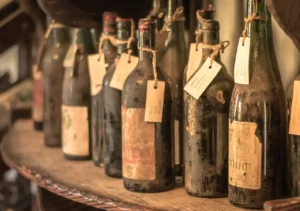
On the other hand, if the humidity is too high, mold can grow on the corks and labels, potentially damaging the wine and its packaging. While mold growth on the exterior of the bottle does not necessarily mean the wine inside is spoiled, it can make the labels difficult to read and the bottles less appealing, which can be a concern for collectors or those planning to resell their wines.
To maintain optimal humidity levels, wine collectors can use humidifiers or dehumidifiers in their storage areas, depending on their local climate and the time of year. Wine refrigerators and professional storage facilities typically have built-in humidity control systems to ensure that wines are kept in their ideal environment.
The Impact of Light on Wines
Exposure to light, particularly UV light, can have a significant impact on a wine’s quality and aging potential. Light can cause a complex series of chemical reactions in wine that can lead to undesirable changes in flavor, aroma, and appearance.
UV light, which is present in both natural sunlight and artificial lighting, can degrade a wine’s color, causing reds to turn brownish and whites to develop a yellowish tinge. This is due to the light’s ability to break down the wine’s pigments and other color compounds. The longer a wine is exposed to UV light, the more pronounced these color changes can become.
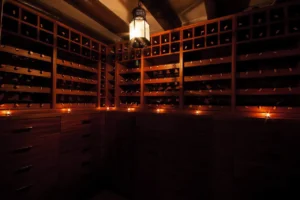
In addition to altering the wine’s appearance, light exposure can also cause the formation of hydrogen sulfide compounds, which can lead to off-putting aromas reminiscent of rotten eggs or burnt rubber. These unpleasant aromas are often referred to as “light-struck” flavors and can be particularly noticeable in delicate white wines and Champagnes.
To prevent light damage, wine should be stored in a dark place, away from direct sunlight and artificial light sources. Incandescent bulbs are preferable to fluorescent lights, as they emit less UV radiation. If you are storing wine in a glass-fronted refrigerator or display case, ensure that it has a UV-resistant coating or consider using a light-blocking material to shield your wine from harmful light exposure.
Colored glass bottles, particularly dark green and amber, can offer some protection against light, but they are not a complete solution. Be sure to be extra careful with clear glass bottles, as they are the most susceptible to light damage.
Proper Bottle Orientation
Storing wine bottles horizontally is crucial for maintaining the quality of the wine over time. When a bottle is stored on its side, the wine remains in constant contact with the cork, keeping it moist and fully expanded. This is important because a moist cork helps to maintain a tight seal, preventing air from entering the bottle and causing oxidation.
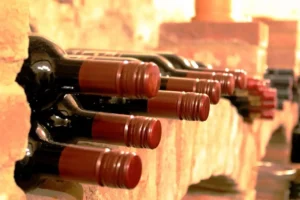
If a wine bottle is stored upright for an extended period, it can cause the cork to dry out and shrink, allowing air to seep into the bottle and interact with the wine. Oxidation can cause a wine to lose its fresh, fruity characteristics and develop unpleasant flavors and aromas.
Horizontal storage also helps to prevent the formation of sediment in the neck of the bottle. As wines age, they naturally produce sediment, which can be bitter and unpleasant if consumed. By storing bottles on their sides, the sediment can settle evenly along the side of the bottle, making it easier to separate from the wine when decanting or pouring.
It is important to note that while horizontal storage is ideal for most wines, there are some exceptions. Sparkling wines, such as Champagne and Prosecco, are best stored upright to minimize the surface area in contact with the cork. This is because the high pressure within the bottle keeps the cork moist and expanded, reducing the risk of oxidation.
The Importance of Ventilation
Proper ventilation is a crucial aspect of wine storage that helps maintain the quality and integrity of your wine collection. Adequate ventilation helps to regulate temperature and humidity levels, preventing the growth of mold and other contaminants, and minimizing the risk of musty or stale odors. By promoting air circulation, ventilation ensures that cool air is evenly distributed throughout the storage area, preventing hot spots or temperature fluctuations that can damage the wine. This is crucial for the gradual and proper aging of wine, as it allows the complex flavors and aromas to develop slowly over time.
Ventilation also plays a key role in regulating humidity levels in the storage area. As mentioned in the humidity section, maintaining the right balance of moisture in the air is essential for keeping corks moist and preventing oxidation. Additionally, poor ventilation can lead to the accumulation of subtle aromas released by the wines over time, which can eventually permeate the corks and affect the taste of the wine.
When storing wine at home, ensure that your storage area has adequate ventilation through the use of fans, vents, or air conditioning systems that promote air circulation while maintaining the desired temperature and humidity levels. Wine refrigerators with built-in ventilation systems are also a good option. For those serious about wine collecting or with extensive collections, professional wine storage facilities offer the ideal environment for long-term storage, featuring state-of-the-art ventilation systems designed to maintain perfect temperature and humidity levels while promoting optimal air circulation.
The Costs and Benefits of Professional Wine Storage
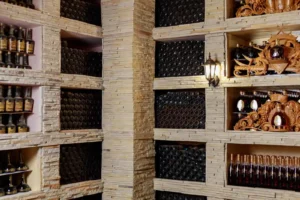
For serious wine collectors, investors, and enthusiasts, professional wine storage offers a range of benefits that can help ensure the optimal preservation and aging of their valuable collections. These facilities provide the ideal environment for wine storage, with state-of-the-art systems that maintain perfect temperature, humidity, and ventilation levels. While there are other wine storage options it’s hard to beat the benefits that professionals can provide including:
- Consistency and reliability of storage conditions, including redundancy in the case of emergencies (such as back-up generators, ventilation, etc.)
- Enhanced security features to protect your collection
- Knowledgeable staff who can provide expert advice on wine storage, aging, and collection management
- Potential to maximize the value of your collection when selling in the future
While the benefits of professional wine storage are clear, it’s important to consider the costs associated with these services. The cost of professional wine storage can vary depending on factors such as the location of the facility, the size of your collection, and the level of service you require. According to Yelp, the average cost for professional wine storage services is between $50 – $250/month depending on the size of the collection and if any add-on services are required.
While you can look into converting a portion of your home into suitable storage space for your wines, the one-off cost for this can be prohibitively expensive. Wine refrigerators can be cost effective, with most ranging between $300 to $3,500, but they are limited in the number of bottles that they can store.
When evaluating whether or not you’d like to invest in professional wine storage, consider the following:
- Potential long-term savings by reducing the risk of spoilage, premature aging, or damage to your collection
- The added peace of mind and convenience of professional storage with robust redundancy and security services
- Additional services offered, such as inventory management, appraisal, or transportation, which can simplify the management of your collection
Ultimately, the decision to invest in professional wine storage depends on your individual circumstances, the size and value of your collection, and your long-term goals as a collector or investor. For many serious collectors and enthusiasts, the peace of mind, convenience, and optimal storage conditions provided by professional facilities are well worth the investment, but every situation is different, so take the time to consider the costs and benefits before making a decision.
Wrap Up
Proper wine storage is essential for protecting your investment, ensuring optimal taste, and maximizing the longevity of your wine collection. By understanding the key factors that influence wine storage, such as temperature, humidity, light, bottle orientation, and ventilation, you can create the ideal environment for your wines to age gracefully and develop their full potential.
Improper storage conditions can lead to a range of issues, including premature aging, loss of flavor, and deterioration of the wine’s overall quality. These issues not only affect the enjoyment of your wine but can also have a significant impact on its value, particularly for rare or collectible bottles.
At GrtWines, we understand the importance of proper wine storage and are committed to providing our clients with the best possible solutions. By working with experienced negociants, we ensure that the wines backing our tokens are stored in state-of-the-art facilities with perfect temperature, humidity, and ventilation levels. Our storage solutions are designed to cater to the needs of serious wine collectors, investors, and businesses who demand the highest standards of care for their collections.
If you’re looking for help getting started check out our FAQ or our post linked below:

